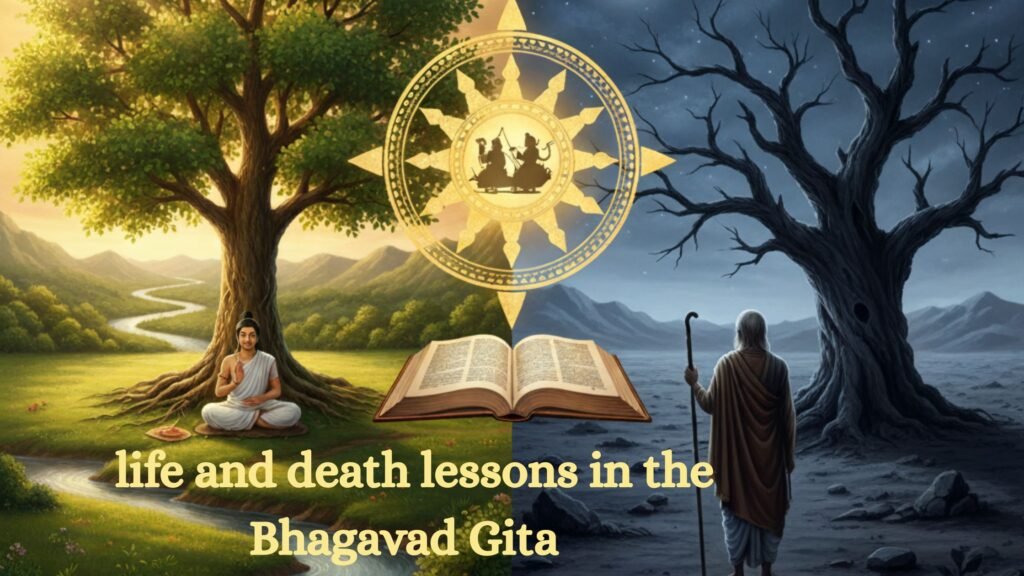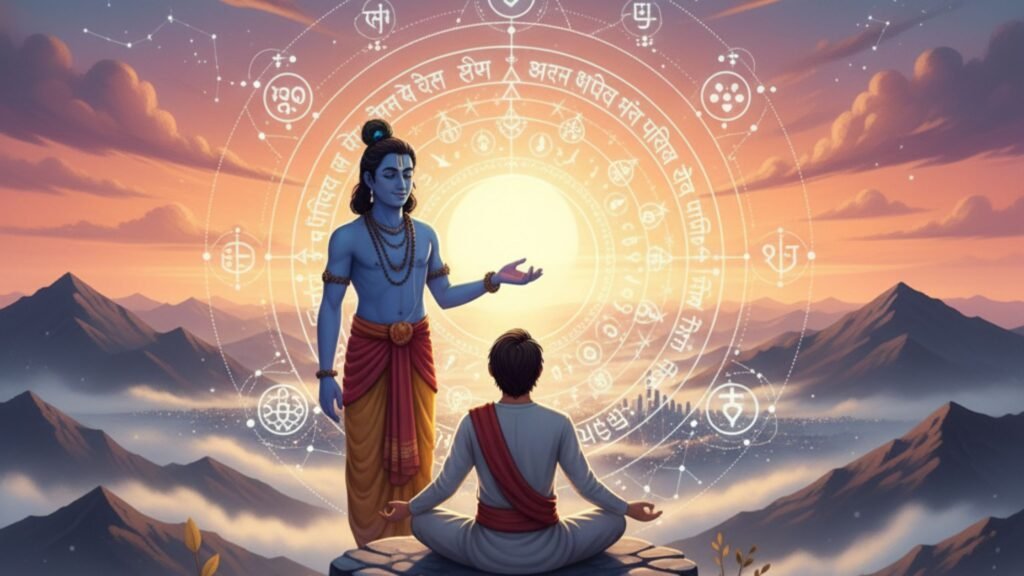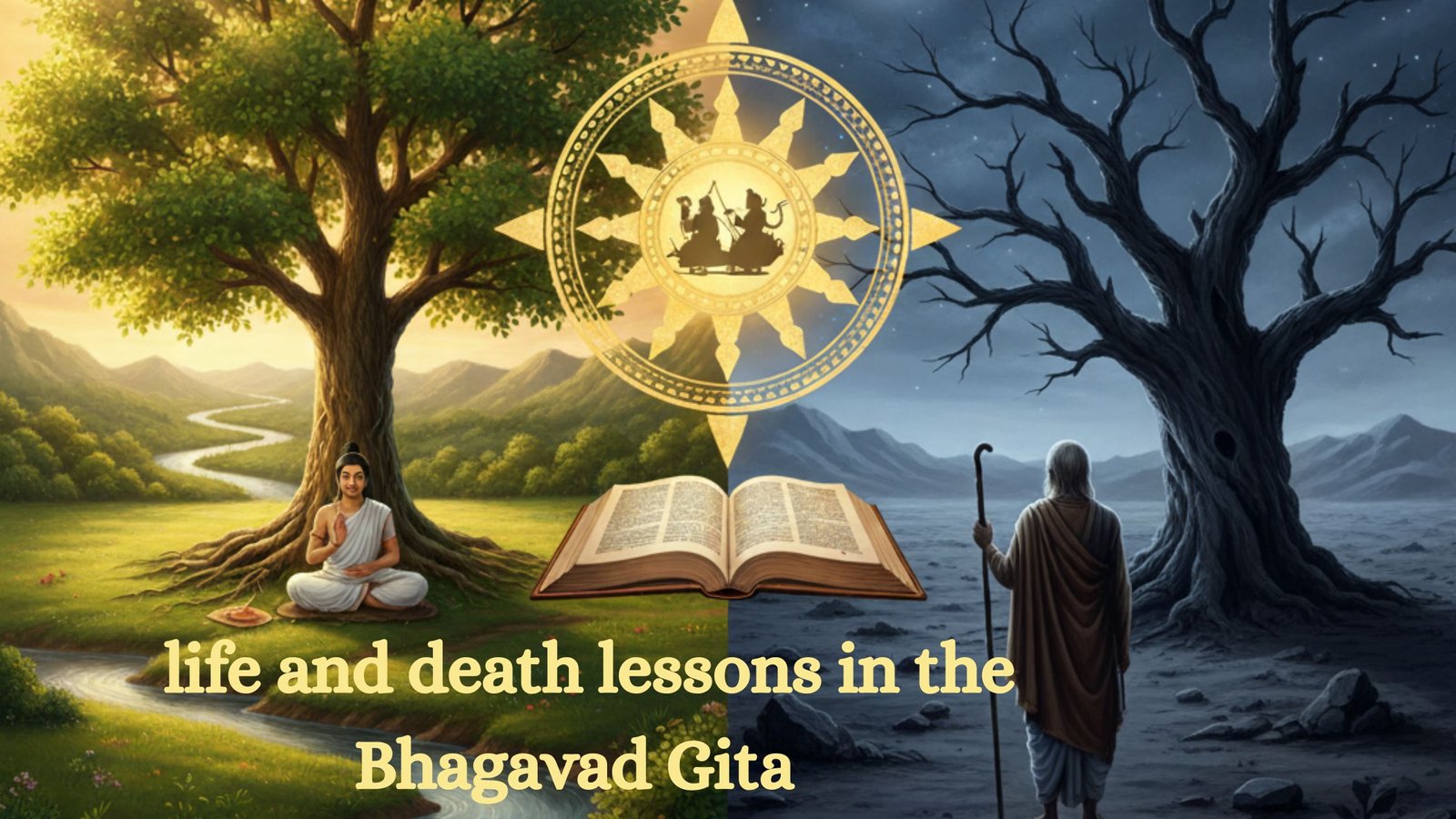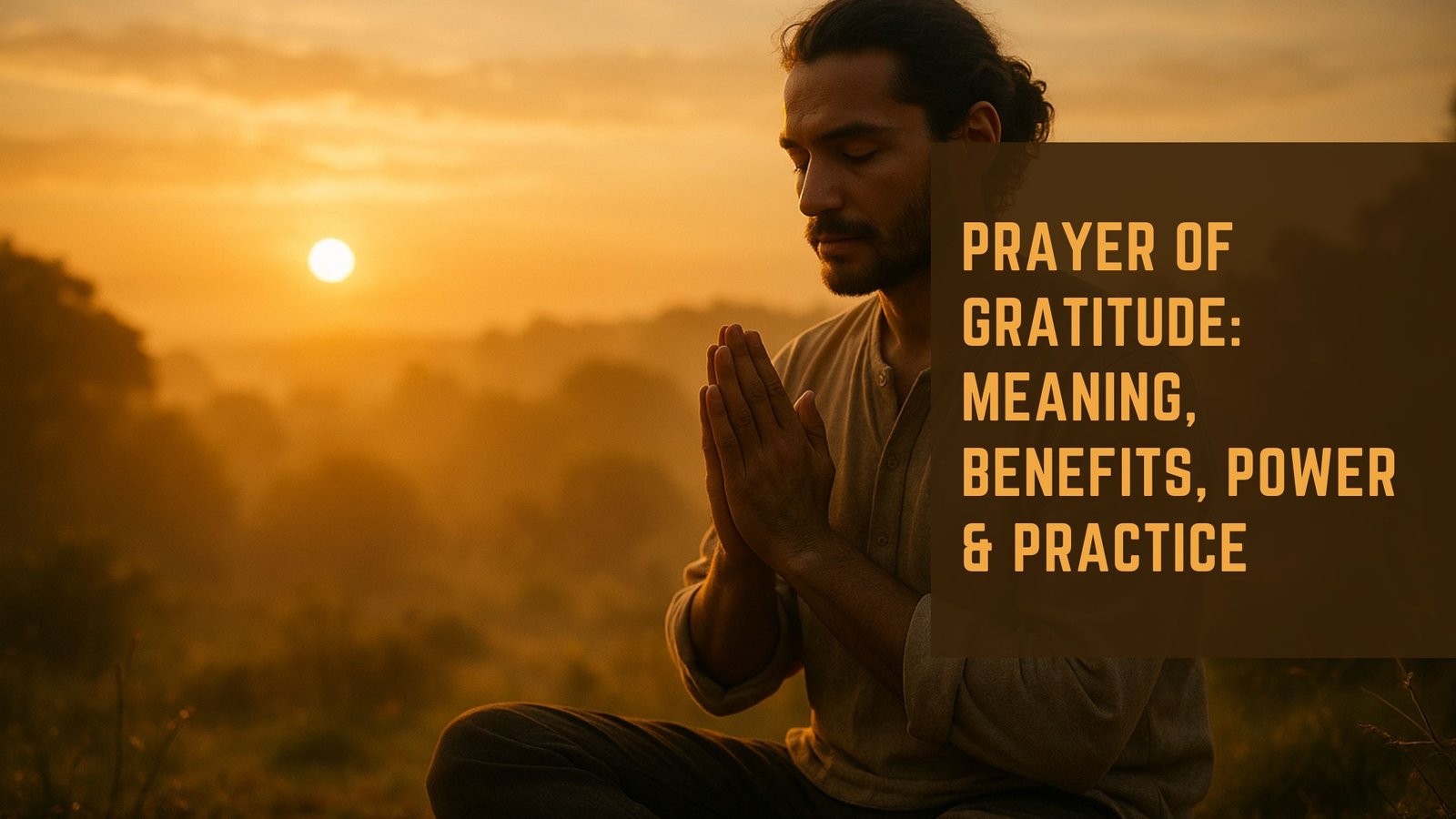Discover the profound life and death lessons in the Bhagavad Gita and learn about the eternal soul in Bhagavad Gita. Explore Lord Krishna’s teachings on the soul, rebirth, and how understanding these truths can bring peace, clarity, and spiritual growth.
One of the key insights of the Gita is the understanding of the eternal soul in Bhagavad Gita, which is the true self beyond the physical body. By grasping this concept, we gain clarity, peace, and purpose.

Table of Contents
🌼 The Eternal Soul: Beyond Birth and Death
Lord Krishna explains to Arjuna that the soul, or Atman, is immortal. In Chapter 2, Verse 20, He says:
“For the soul, there is neither birth nor death at any time.
It has not come into being, does not come into being, and will not come into being.
The soul is unborn, eternal, ever-existing, and primeval; it is not slain when the body is slain.”
This teaching highlights that while the body perishes, the eternal soul in Bhagavad Gita remains untouched, continuing its journey beyond this life.
🌿 Death as a Natural Transition
The Gita presents death not as an end, but as a transition to another stage of existence. Krishna compares the soul’s journey to changing clothes in Chapter 2, Verse 22:
“As a person puts on new garments, giving up old ones,
the soul similarly accepts new material bodies, giving up the old and useless ones.”
This illustrates that life and death are part of a continuous cycle, and the soul never truly dies.
🌞 Understanding Rebirth and Karma
One of the most important life and death lessons in the Bhagavad Gita is the principle of rebirth. Krishna reminds Arjuna in Chapter 2, Verse 27:
“For one who has taken birth, death is certain;
and for one who has died, birth is certain again.
Therefore, you should not lament over the inevitable.”
This verse teaches that every life is temporary, and the soul progresses according to its karma. The eternal soul in Bhagavad Gita experiences this cycle until it achieves self-realization and liberation.

🌸 Purpose of Life: Self-Realization
The Gita emphasizes that the true purpose of life is self-realization — understanding the eternal nature of the soul and living in harmony with Dharma. Attachment to the temporary body and material gains creates suffering, but awareness of the eternal soul in Bhagavad Gita brings peace and spiritual clarity.
“The wise lament neither for the living nor for the dead.”
(Chapter 2, Verse 11)
By embracing this knowledge, we can face life’s challenges without fear and act with wisdom.
🌻 Key Life and Death Lessons from the Gita
Here are the major lessons on life and death according to the Bhagavad Gita:
- The soul is eternal — beyond birth, death, and physical existence.
- Death is not the end, but a step in the eternal journey of the soul.
- Perform duties without attachment to results, focusing on righteous action.
- Acceptance of change brings inner peace and reduces fear of death.
- Self-realization leads to liberation (Moksha), freeing the soul from the cycle of rebirth.
These life and death lessons in the Bhagavad Gita continue to inspire seekers worldwide, helping them live with courage, purpose, and spiritual insight.
🌺 Overcoming Fear of Death
Krishna teaches that understanding the eternal soul in Bhagavad Gita helps overcome fear. When we realize that the soul is imperishable, we can face life and death with equanimity. Every ending is simply a new beginning, and each life is an opportunity for growth, learning, and spiritual evolution.
“The soul can never be cut into pieces by any weapon,
nor burned by fire, nor moistened by water, nor withered by the wind.”
(Chapter 2, Verse 23)
This assurance reminds us that our true self is always safe, eternal, and divine.
FAQ
Q: What are the main life and death lessons in the Bhagavad Gita?
A: The Bhagavad Gita teaches that the soul is eternal, death is a transition, and every life is part of a continuous cycle. Understanding these life and death lessons in the Bhagavad Gita helps us live fearlessly and with spiritual clarity.
Q: What does the Bhagavad Gita say about the eternal soul?
A: The Gita explains that the eternal soul in Bhagavad Gita never dies or is destroyed. While the body changes, the soul continues its journey through rebirth until self-realization is achieved.
Q: How can we apply the life and death lessons from the Bhagavad Gita in daily life?
A: By focusing on duty without attachment to results, accepting change, and understanding the eternal soul in Bhagavad Gita, we can live with peace, balance, and purpose.
Q: Why is understanding life and death important according to the Bhagavad Gita?
A: The life and death lessons in the Bhagavad Gita teach us to overcome fear, reduce attachment, and focus on spiritual growth. Realizing the soul’s immortality gives us courage and clarity in life.
Q: What role does karma play in life and death according to the Gita?
A: Karma determines the soul’s journey in the cycle of birth and death. By understanding these life and death lessons in the Bhagavad Gita, we learn to act righteously, perform our duties, and prepare the soul for spiritual progress.
🌼 Conclusion
The life and death lessons in the Bhagavad Gita offer timeless wisdom for understanding the soul, embracing change, and living a purposeful life. By internalizing these teachings, especially the knowledge of the eternal soul in Bhagavad Gita, we gain courage, clarity, and the peace that comes from spiritual awareness.
The Bhagavad Gita is not just a scripture; it is a guide to living fearlessly, acting wisely, and accepting life and death with grace.
“Every challenge we face is an opportunity to grow; embrace life lessons with courage and gratitude.”











